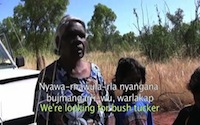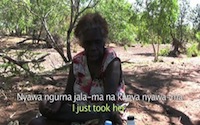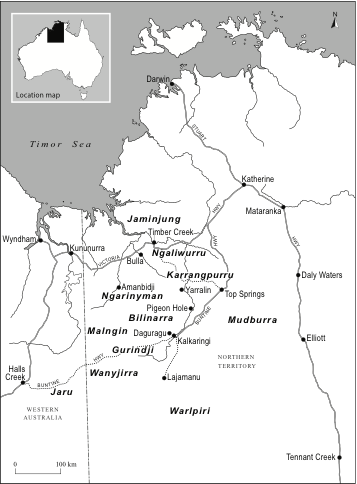Overview
The aim of the project is to document the linguistic and cultural knowledge of the remaining few hundred speakers of several language varieties belonging to two language groups in the Victoria River District in Northern Australia. These varieties are Jaminjung, Ngaliwurru and Nungali (members of the Jaminjungan family, one of the Non-Pama-Nyungan language groups) and Gurindji, Ngarinyman, and Bilinarra (belonging to the Ngumpin subgroup of the Pama-Nyungan language family). These varieties (and in addition English, Kriol, an English-lexified creole, and Gurindji Kriol), constitute part of a single network of multilingual communicative practices in the region, since the speakers of these languages have been in close contact for probably centuries.
One aim of the project is therefore to document dialectal and ideolectal variation as well as language contact phenomena in an attempt to do justice to the everyday use of language in such a multilingual setting. Focal areas for the text collection are topics such as significant places, knowledge associated with the local plants and animals, and local history, which are likely to be of particular interest to the speakers and their descendants as well as to linguists, anthropologists, biologists, ecologists, and historians.
Texts have been transcribed and annotated in the format advocated by the DoBeS programme. The documentation will be complemented by dictionaries of each of the varieties and sketch grammars. The project also included funds for the production of literacy and other learning materials in cooperation with the speech communities. The project took place in close collaboration with the Diwurruwurru-Jaru Aboriginal Corporation, an Aboriginal Language Centre based in Katherine (N.T.) (now called Mimi Ngurrdalingi Aboriginal Corporation).
Genealogical affiliation
The Jaminjungan language group (also referred to as Djamindjungan, Yirram or Western Mirndi in the literature) today only consists of two closely related dialects, Jaminjung and Ngaliwurru (Ethnologue code: DJD). A third, less closely related variety, Nungali, now has no fluent speakers left. The Jaminjungan group has been shown by Neil Chadwick to be a subgroup of the Non-Pama-Nyungan Mirndi language family, including languages like Wambaya and Jingulu. All other Mirndi languages, however, are now geographically discontinuous from the Jaminjungan languages, with no shared network of speakers, and the two groups have diverged considerably in their vocabulary and in their grammatical properties.
The Eastern Ngumpin language group is a subset of the Ngumpin subgroup of the Ngumpin-Yapa languages, and a member of the Pama-Nyungan language family. The Ngumpin languages are not related to the Jaminjungan languages but share many structural and lexical features due to long-term contact. The Eastern Ngumpin varieties included in the scope of this project are Gurindji (Ethnologue code: GUE), Bilinarra, and Ngarinyman (Ethnologue code: NBJ), which are closely related. Other languages of the Ngumpin group are Mudburra spoken to the east, as well as Malngin, Nyininy, Wanyjirra, Jaru and Walmatjarri in the west.
The figure below shows the family relationships between the Jaminjungan and the Eastern Ngumpin languages and related languages.
Language Contact between traditional languages
Speakers of Jaminjungan and Eastern Ngumpin languages have been in contact for a long time, probably for centuries. They have also been in contact with languages of other neighbouring language families such as Wardaman to the east and the Jarragan languages Miriwoong and Gajirrabeng to the west. Most older speakers of one of the Jaminjungan and Eastern Ngumpin variety are multilingual in that they speak two or more of the traditional languages, and Kriol as well.
Because of the tradition of multilingualism, the traditional languages of the region show many similarities in their sound systems and in their grammatical structures. For example, all of these languages have a closed class of inflecting verbs with around 30-40 members which form complex predicates with members of a distinct word class (termed “uninflecting verbs”, “coverbs” or “preverbs” in the literature). In addition, the languages share many lexical items, for example words for plants and animals. With more recent borrowings, it is possible to observe a lot of individual variation in their usage, and thus to document language change in progress.
Kriol and Gurindji Kriol
The first language of many younger people in the northern Victoria River District and the lingua franca between indigenous people of a wider region in northern Australia is Kriol (also called Roper River Kriol; Ethnologue code: ROP). Kriol arose from contact between white pastoralists who spoke English, and speakers of indigenous languages who worked on the cattle stations. Its vocabulary is derived from English but its sound system and the meaning of words reflect the local indigenous languages. Its grammar is also quite distinct from English and influenced by the traditional languages of the region.
Due to the widespread use of Kriol in everyday conversation in the last decades, there are now many loan words from Kriol in the Jaminjungan and Ngumpin languages, and code-switching is very common between Kriol and the traditional languages.
In the twin communities of Kalkaringi and Daguragu, a new language, Gurindji Kriol, has emerged which has vocabulary and grammatical properties from both Gurindji and Kriol and can therefore be described as a mixed language.
Language loss and language maintenance
All of the varieties are endangered in that they are no longer acquired by children, and the youngest fluent speakers are at least 40 years old. The first language of younger people and children is Kriol, and in some cases, Gurindji Kriol. The precise number of remaining speakers of the traditional languages is difficult to estimate, but lies between 10 and 150 for each language.
The Jaminjungan and Eastern Ngumpin languages have only ever been used as an oral medium of communication within the family and larger community. Nonetheless orthographies have been developed for the different languages by linguists in collaboration with community members.
The language of education, government and the media is English. However, traditional language programs have existed intermittently in several schools including Amanbidji, Bulla, Pigeon Hole and Kalkaringi, mostly organised and funded by the Diwurruwurru-Jaru Aboriginal Language Centre in Katherine.







